
The best camping sleeping pads can make all the difference in your adventures. Photo: Nathan Lemin//The Inertia
The best camping sleeping pads bring the comfort of sleeping at home to nature. There are durable, comfortable, and spacious sleeping pad options from classic brands and newcomers alike. But with so many to choose from, it can seem daunting to find the best camping mattress for your individual needs. We’re here to help parse out what you need for a good night’s sleep at camp.
We tested well over a dozen of the top sleeping pads to come out this year, as well as some tried and true favorites. Spoiler alert: The Exped MegaMat 10 was our pick for the best camping sleeping pad this year. This complete guide features our top picks in a variety of categories, from plush foam and air sleeping pads to lighter-weight options you can also bring backpacking.
Navigate To: Comparison Table | Buyer’s Guide | How We Tested
Related: Best Backpacking Sleeping Pads | Best Sleeping Bags | Camping Gear Reviews
Editor’s Note: We updated this guide in August 2025 by adding a new pick (the awesome Hest Dually), improving formatting, refreshing links, and removing out-of-stock products.
The Best Camping Sleeping Pads of 2025
Best Overall Camping Sleeping Pad: Exped MegaMat 10
Best Double Sleeping Pad: NEMO Roamer Double
Best Budget Camping Mattress: Coleman QuickBed Single High Air Mattress
Best Value Camping Sleeping Pad: REI Co-op Dreamer
Best Foam Camping Mattress: Hest Dually Mattress
Best For Sleeping in Your Car: Luno Air+Foam Pro Vehicle Mattress
Best Overall Camping Sleeping Pad
Exped MegaMat 10 ($240)
Weight: 4 lbs 9 oz
Thickness: 4″
Dimensions: 72.1″ x 25.6″
Materials: Open-cell foam, polyester
R-Value: 8.1
Pros: Plush top, easy to use, durable, comfortable
Cons: Included pump is small, takes a while to inflate
Exped has made a name for itself delivering just what people need to sleep comfortably in the outdoors, and the MegaMat is exhibit A. This is what you want to take with you to the campsite if you are car camping or don’t have far to walk. Even if you do need to make a few trips to the car, it’s worth it. The MegaMat self-inflates in no time (after the first use) and just needs a bit of a top-off with the included hand pump that doubles as a pillow. It’s not a huge pump and will take a while on the first go, so keep that in mind.
The top is well-cushioned to give a bit of comfort on its own, but the secret sauce is the open-cell foam used inside. Not only is it über-comfortable, it is well-insulated and boasts one of the highest R-Values (8.1) of all the mats we tested. Sure, you probably won’t be thru-hiking with this, but you probably already knew that. If you aren’t inflating and deflating every night and morning, you’ll be treated with comfort, relative quiet, and warmth for a long time to come.
Read our full review of the Exped MegaMat 10.
Check Price on REI Check Price on Backcountry
Best Double Sleeping Pad
NEMO Roamer Double ($400)
Weight: 7 lbs 8 oz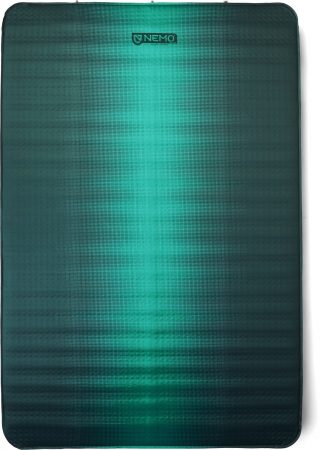
Thickness: 4″
Dimensions: 78″ x 52″
Materials: Recycled polyester + foam
R-Value: 6
Pros: Extremely comfortable, lighter and more packable than other double sleeping pads
Cons: Still bulky and doesn’t pack easily into stuff sack
The NEMO Roamer Double is right up there with the Exped MegaMat as a top-tier camping sleeping pad. The better weight-to-thickness ratio on the Roamer makes it a great pick for a double sleeping pad, as it packs down a bit smaller than the Megamat in double form. It’s also lighter while boasting the same 4-inch thickness. The R-value is a bit lower due to those lighter materials, but the NEMO Roamer Double is one seriously comfortable sleeping pad.
While, like others on this list, the Roamer is considered a “self-inflating” sleeping pad, we found that it only got us so far. The included pump sack is a nice touch, and we found it to be really easy to use. That said, it takes a long time to fill such a large sleeping pad with just a pump sack, so we’re huge advocates for getting a small compressor like a Flextail to bring along. Once topped up, the Roamer is one of the most comfortable sleeping pads we’ve ever tried. It’s stable and firm to the edge, but soft enough with the built-in foam to feel like your mattress at home. We found the double to be plenty roomy enough for two, and one of our editors has even fit two adults and two large dogs on the pad (though it was a squeeze).
Drawbacks of the NEMO Roamer include weight, bulk, and cost. While it’s still lighter than the Exped MegaMat Duo, the Roamer is still about seven and a half pounds. And we found it nearly impossible to fit in the included stuff sack (but it fits easily in the larger “duffel” style bag). Plus, at $400, this is a serious investment in your campsite sleep. Do we think it’s worth it? Unequivocally. Durability, comfort, and user-friendliness have been superb in our experience, but if you’re looking for a bit more affordable option, consider the Camp Dreamer below.
Check Price on REI Check Price on Backcountry
Best Budget Camping Mattress
Coleman QuickBed Single High ($35)
Weight: 5 lbs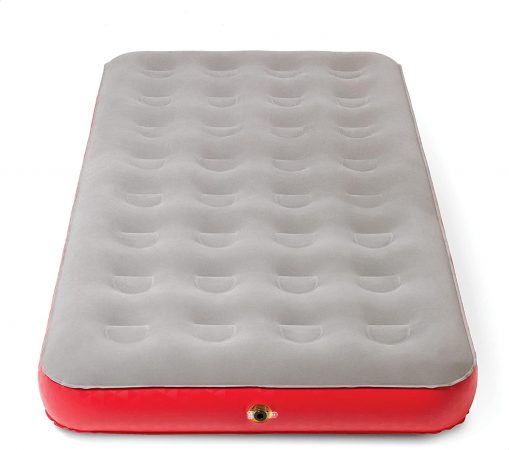
Thickness: 8″
Dimensions: 73″ x 38″
Materials: Not specified
R-Value: Not specified
Pros: Inexpensive, keeps you high off the ground
Cons: Surface isn’t most comfortable, susceptible to punctures
Let’s be real: The Coleman QuickInflate Single High is pretty much just your basic air mattress. And it’s also regularly less than $40. So, while it’s not the comfiest camping mattress we’ve ever slept on, it does the job. Our standard qualm with air mattresses for camping is that they don’t tend to last. That said, so far, so good with this Coleman offering: We’ve been testing one for about six months and have had no issues.
Characteristic of air mattresses, the QuickInflate has a sort of bumpy surface. It’s not as comfortable as the options with integrated foam, but when it is fully inflated, the bed is supportive and provides good insulation from the ground. At 8 inches, the bed is thicker than others on this list, but if your tent walls slope drastically, the height of this air mattress might push up against them. With that in mind, the Coleman is best suited to a larger tent.
The Coleman QuickBed is a solid camping mattress, especially when you consider it can be had for less than $40. We recommend being gentle with it, as camping sleeping pads that only rely on air are susceptible to punctures.
Check Price on Coleman Check Price on AMAZON
Best Value Camping Sleeping Pad
REI Co-Op Camp Dreamer ($179)
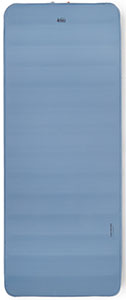 Weight: 78 oz
Weight: 78 oz
Thickness: 4″
Dimensions: 78″ x 30″
Materials: Recycled polyester + foam
R-Value: 6.6
Pros: Great value, excellent comfort
Cons: Takes a while to self-inflate
We’d say that the Camp Dreamer trends more to the realm of a “mattress” than a mere “sleeping pad” due to its size, which takes up a whole shelf width even when rolled up. But that’s not to say you can’t take it camping, especially of the car-camping variety. With more foam than other pads we tested, it offers primo comfort that really isn’t too hard to pack.
If you have had it packed away for a few months and pull it out, plan on the self-inflating feature taking up to half an hour. But this isn’t for tired backpackers after a long day on the trail; the best use for this is a weekend with a fully loaded car or truck, where you can focus on getting the barbecue ready or gathering firewood while it inflates.
Best Foam Camping Mattress
Hest Dually Mattress ($529-$629)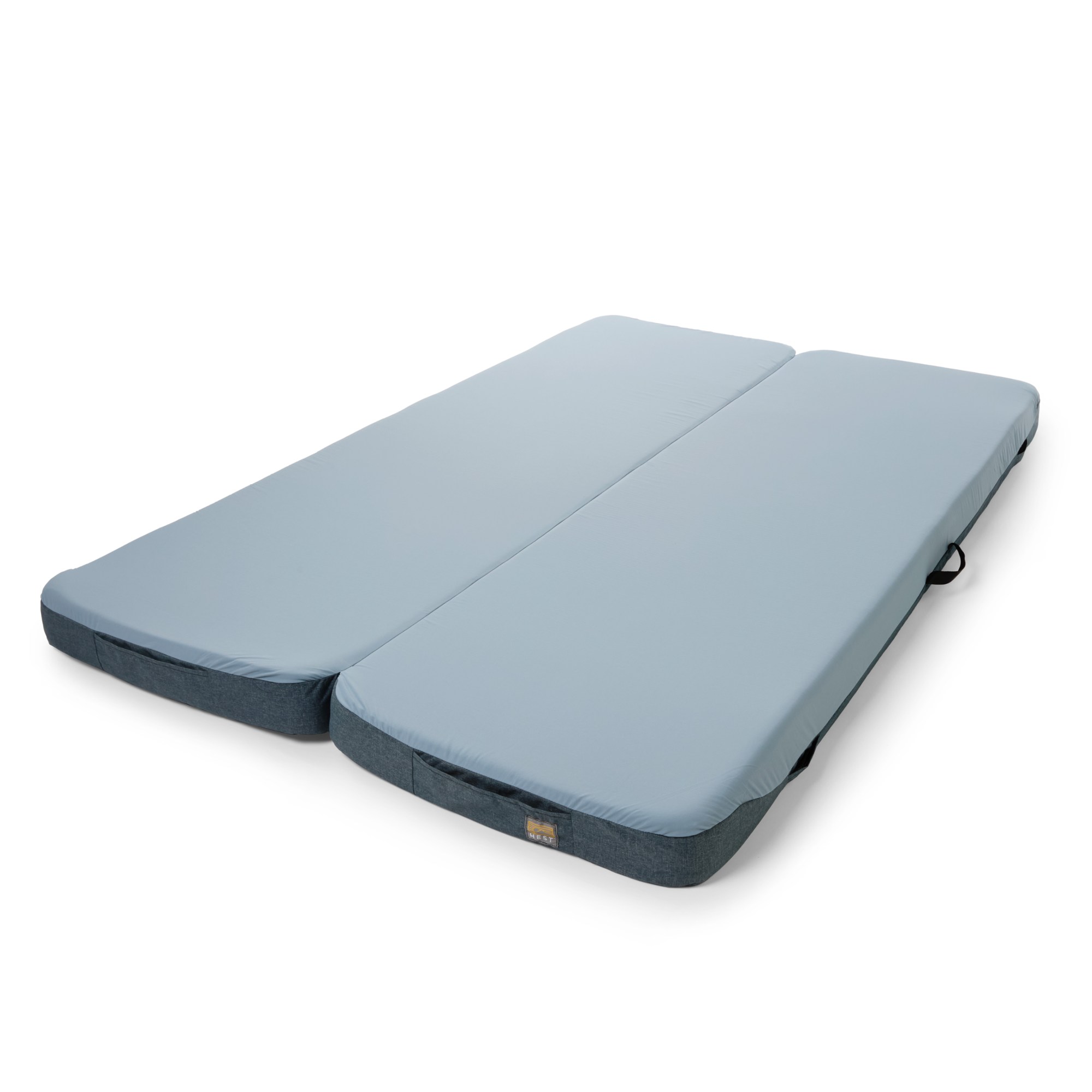
Weight: 26 pounds (size wide)
Thickness: 3.9″
Dimensions: 72″ x 60″ (size wide)
Materials: Recycled polyester + foam
R-Value: 11.8
Pros: Best comfort of any on this list, excellent permanent/semi-permanent setup
Cons: Very bulky, pricey
The best sleep we’ve ever gotten at camp? Without a doubt, we were sleeping on a Hest Dually Mattress. Although it isn’t very packable (it does best in a semi-permanent vehicle setup or when you have plenty of space), it is far and away the most comfortable option that we’ve tested. With dual-layer foam, the Dually completely eliminates ground feel, and it doesn’t have any of the annoying shifting and bulging that an air/foam hybrid pad might.
Sure, the Hest Dually takes up more space than some of the other options, but we haven’t let that prevent us from bringing it on every trip. We tested the wide, which, for two sleepers (and a pile of dogs), provided more usable space than we’ve ever had camping. Plus, our tent got flooded on one trip, and the tough, resistant bottom layer didn’t flood out and we were able to dry the mattress super quickly. If money and space were not ever an issue, this is the option we’d most recommend.
Check Price on REIBest for Sleeping in Your Car
Luno Air+Foam Pro Vehicle Mattress ($500)
Weight: 12 pounds
Thickness: 4″
Dimensions: Vehicle-dependent
Materials: Recycled polyester + foam
R-Value: 11
Pros: Cut to fit vehicles, can be double or single, comfortable
Cons: Not as wide as other hybrid mattresses, lacks some accessories/features
Luno has been on our radar for a while now, and their sleek, useful offerings for car camping have continued to improve. While Luno has featured air mattresses that are cut to fit vehicles in their lineup for a while, they just recently brought their “Air+Foam” technology to their vehicle-specific beds. And we are stoked! The Luno Air+Foam Pro Vehicle Mattress’ construction is similar to the “best of both worlds” camping sleeping pads like the MegaMat or Roamer above, but with convenient cutouts for the wheel wells of your SUV, car, or truck.
Aside from the vehicle-specific cut of this mattress, one of our favorite features is the fact that you can zip this sleeping pad in half to use it as a single pad (or two single pads). For a pricey camping mattress, that versatility adds a lot of value, especially if you want to use the Luno Air+Foam Pro Vehicle Mattress in a tent or for other camping adventures. Probably the best part about purchasing the Luno, too, is that they take the guesswork out of vehicle fit. Simply enter the make, model, and year of your vehicle, and they’ll tell you if the mattress fits, and then send you the appropriate kit to ensure you get a comfortable sleep setup.
One of our main downsides to the Luno Air+Foam Pro Vehicle Mattress is that, due to the cutouts, the mattress does feel a bit smaller than other double camping sleeping pads. That said, we were satisfied with the extra room near the head and shoulders. The other drawback is that this sleeping pad lacks some of the bonus accessories (multi-valve system, smaller stuff sack, etc) of other options, especially considering that it is the most expensive option on our list.
All said the Luno Air+Foam Pro Vehicle Mattress is our top pick for folks who want to sleep in the car. While it can’t match the outright comfort of the MegaMat, this excellent camping sleeping pad fits a variety of SUVs, zips in half to create two single sleeping pads, and features a comfortable blend of foam and air.
Best of the Rest
Another Great Foam and Air Pad
Sea To Summit Comfort Deluxe ($249)
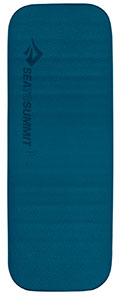 Weight: 70 oz
Weight: 70 oz
Thickness: 4″
Dimensions: 72″ x 25″
Materials: Foam + Polyester
R-Value: 6.5
Pros: Firm and quiet
Cons: Self-inflation does not work well out of the box
For a self-inflating semi-foam sleeping pad, the Sea to Summit Comfort Deluxe is one of our top choices. It just missed our top picks as it comes in at a slightly higher price point than its counterparts. But we could find little wrong with it, and the comfort speaks for itself. We found it nice and firm, and easy to top up after the self-inflation started. Speaking of which, that was the biggest challenge here – when taking it out for the first time, the pad did not want to inflate right away. So we suggest taking it out at home and letting it do its thing to avoid playing the waiting game at the campsite.
It’s easy to inflate, and even easier to deflate thanks to its quick-release valve. So if you’re a last-minute packer and want to squeak every last second out of your weekend before it’s time to call it quits, this might be the right sleeping pad for you.
Check Price on REI Check Price on Backcountry
Comfortable and Spacious
Therm-a-rest MondoKing 3D ($240)
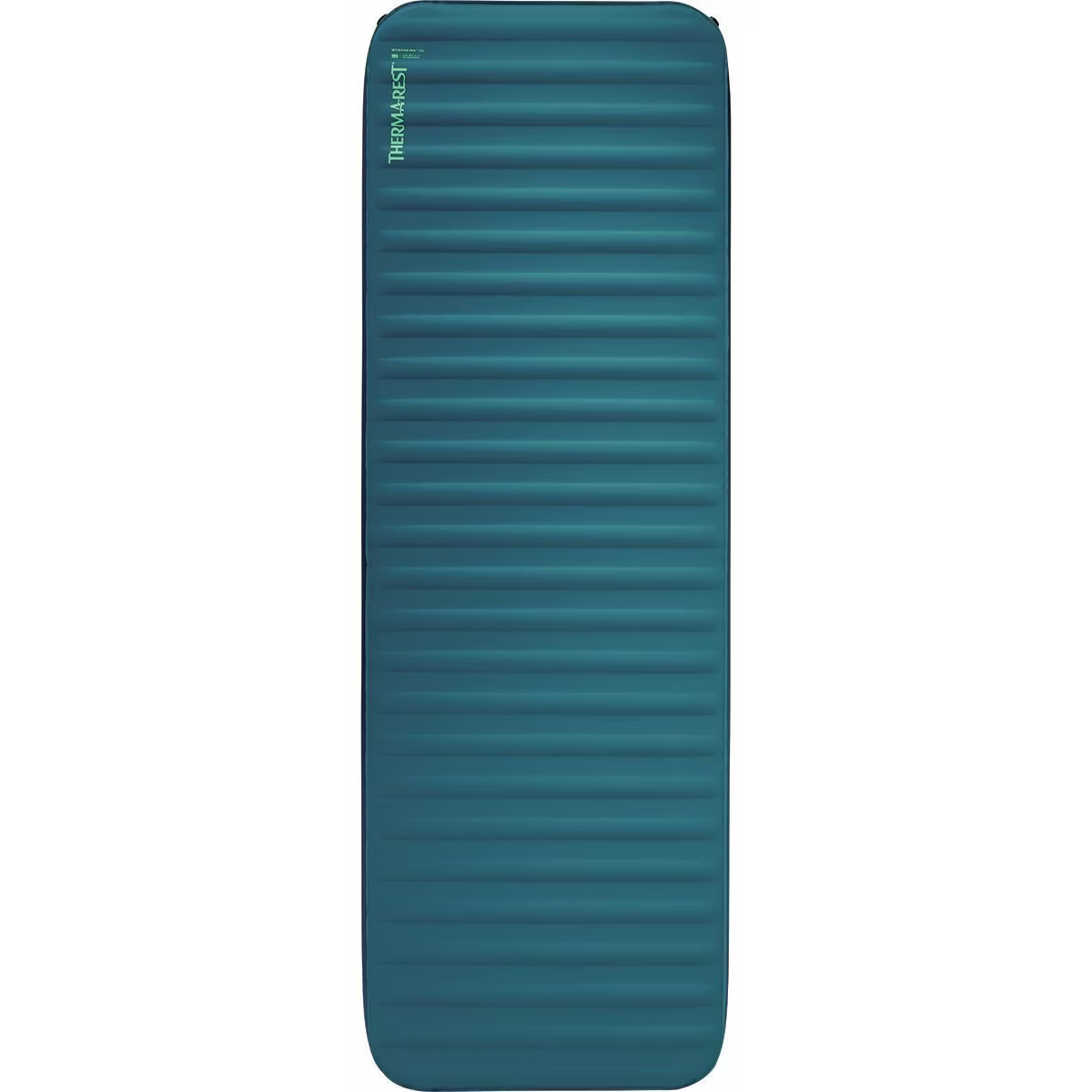 Weight: 70 oz
Weight: 70 oz
Thickness: 4.25″
Dimensions: 77″ x 25″
Materials: Polyester, polyurethane
R-Value: 7
Pros: Warm, comfortable
Cons: Can be bulky, awkwardly sized
The Therm-a-rest MondoKing 3D is more of a mattress and was so comfortable that it’s now a go-to at home for people sleeping over. It rarely gets put away, in fact, because it’s just comfy to have for movie night and a multitude of other uses. It’s not immune to dogs’ claws, though — as one of our testers, unfortunately, found out — so be careful. But that’s more to do with our tester not giving his dog a proper manicure when it was needed.
With the combo of foam and air to give you a custom firmness, it’s arguably more comfortable than other mattresses. The width was a bit of a challenge in that it’s not quite double wide, but it’s wide enough that in a two-person tent, you can’t use another mattress easily. If you have a 3-person tent, it could be a bit more manageable, and a 1-person tent is out of the question in most cases. But if you can find the sweet spot or don’t need to play Tetris with another mat inside a tent, you’ll be happy to have this to lie on.
Check Price on REI Check Price on AMAZON
Most Durable Camping Sleeping Pad
NRS Snooze Pad 2 ($300)
 Weight: 82 oz
Weight: 82 oz
Thickness: 2″ (3″ and 4″ available)
Dimensions: 72″ x 24″
Materials: TPU-coated nylon
R-Value: 7.6
Pros: Extremely durable
Cons: Packs up large
Made to sprawl out on riverbanks and other places where you might not be inside a tent, the Snooze Pad 2 by NRS is made to be used and abused more than your average inflatable camping sleeping pad. It’s certainly on the heavy side, but the thick exterior means you can toss it around without worrying about having to keep a patch kit handy. Obviously, there are limits to this, but even on sharp sticks and rocks, this pad held up with no issues.
The Snooze Pad 2 can also double as a seat or extra insulation for your cooler when not being used as a mattress, so this pad definitely goes far beyond the realm of sleeping for its usefulness. We liked the relative portability of the two-inch version, but it also comes in three- and four-inch versions for extra buoyancy and comfort, which is great if you have the space to pack it along.
Check Price on REI Check Price on AMAZON
Best Closed-Cell Foam Sleeping Pad
NEMO Switchback ($55)
 Weight: 14.5 oz
Weight: 14.5 oz
Thickness: 0.9″
Dimensions: 72″ x 20″
Materials: Closed-cell foam
R-Value: 6.6
Pros: Easy setup, no risk of puncture
Cons: not as comfortable as an inflatable pad
While most often associated with backpacking, a durable, quick-set-up closed-cell sleeping pad can be a boon on a car camping trip or at a walk-in site. For one thing, you know it’s not going to get holes or sag on you in the middle of the night. And you save considerable time and energy on the setup to boot.
The NEMO Switchback is our testing team’s personal favorite in the category. It’s warm, packs down small (for a closed-cell pad), and provides as much support and comfort as possible. It also holds up well; our tester is coming up on five years with his, with very little foam collapse noticeable.
Check Price on REI Check Price on Backcountry
An Excellent Hybrid Camping Sleeping Pad
Big Agnes Boundary Deluxe ($180)
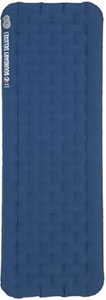 Weight: 25 oz
Weight: 25 oz
Thickness: 3.5″
Dimensions: 72″ x 20″
Materials: Ripstop nylon bottom, Nylon/spandex top
R-Value: 4.3
Pros: Comfortable and relatively quiet
Cons: On the heavier side for an inflatable pad.
If you’re looking for a pad comfortable enough for car camping but light enough to carry along on a backpacking trip, say hello to the Big Agnes Boundary Deluxe.
A common problem with ultralight sleeping pads is that they can feel like sleeping on a balloon. The plastic feel, combined with crinkling as you roll over, is no fun. But Big Agnes has found a great solution by adding a top layer that doesn’t give you the balloon feel while still providing good insulation. And the best part is the Big Agnes Boundary Deluxe weighs just over a pound and a half.
The secret is in the spandex, which is an explanation we never thought we’d offer in a review. But the little bit of stretch allows the pad to (quietly) cradle your body without being overly soft. Altogether, it’s a unique package that differs from other sleeping pads and still packs up remarkably small despite being a bit heavier than other backpacking-friendly pads we tested.
Check Price on REI Check Price on Backcountry
Best Camping Sleeping Pads Comparison Table
| Name | Price | Weight | Thickness | Dimensions | Materials | R-Value |
| Exped MegaMat 10 | $240 | 73 oz | 4″ | 72.1″ x 25.6″ | Open-cell foam, polyester | 8.1 |
| NEMO Roamer Double | $400 | 7 lbs 8 oz | 4″ | 78″ x 52″ | Foam, polyester | 6 |
| Coleman QuickBed Single High | $35 | 5 lbs | 8″ | 73″ x 38″ | Not specified | N/A |
| REI Co-Op Camp Dreamer | $179 | 78 oz | 4″ | 78″ x 30″ | Recycled polyester + foam | 6.6 |
| Hest Dually Mattress | $529 | 26 lbs | 3.9″ | 72″ x 60″ (wide) | Memory foam | 11.8 |
| Luno Air+Foam Pro Vehicle Mattress | $499 | 12 lbs | 4″ | Vehicle-dependent | Polyester, nylon, PU foam | 11 |
| Sea To Summit Comfort Deluxe | $249 | 70 oz | 4″ | 72″ x 25″ | Polyester + Foam | 6.5 |
| Therm-a-rest MondoKing 3D | $240 | 70 oz | 4.25″ | 77″ x 25″ | Polyester, polyurethane | 7 |
| NRS Snooze Pad 2 | $300 | 82 oz | 2″ | 72″ x 24″ | TPU-coated nylon | 7.6 |
| NEMO Switchback | $55 | 14.5 oz | .9″ | 72″ x 20″ | Closed-cell foam | 6.6 |
| Big Agnes Boundary Deluxe | $180 | 25 oz | 3.5″ | 72″ x 20″ | Ripstop nylon bottom, Nylon/spandex top | 4.3 |

Some of the best camping sleeping pads we tested. Photo: Steve Andrews//The Inertia
How We Tested Camping Sleeping Pads
Testing camping sleeping pads is one of the easier tests we do around here. Most of the testing criteria have a simple yes or no response. Did the sleeping pad provide a good night’s sleep, or was it uncomfortable? Anything that was uncomfortable did not make this list. That was the easy part. We got as many testers to sleep on these pads as possible, and indeed, some folks have differing opinions. The top picks, though, were agreed upon.
Other criteria were a bit more objective, such as the weight and R-value. If the sleeping pad was easy to transport relative to its ability to stay warm on the cold ground, it got another point in its favor.
We also factored in how easy the pads were to inflate, taking into consideration whether it was self-inflating, had a pump sack included, and if the pump sack stayed attached to the valve at all times or occasionally came undone. This, while fairly straightforward, was not easy to compare apples to apples, especially between self-inflating pads and those for which you needed to practice your breathing exercises to avoid getting too lightheaded.
Then, with the pads ready to rest upon, we tucked in for a night in nature. Careful thought went into how the pads felt underneath, especially the noise they would make when moving around to take our own and other people’s sleep into consideration.
Both Steve Andrews and Nathan Lemin contributed testing notes to this guide. We also drew on impressions of certain camping sleeping pads from another tester, Rebecca Parsons. These options were tested all over the continent in different camping settings, from cold nights to warm, in the backcountry and front country. We believe we’ve chosen an excellent group of camping sleeping pads that suit and serve a wide variety of campers.

We preferred camping sleeping pads with one-way valves for easy inflation. Photo: Nathan Lemin//The Inertia
Camping Sleeping Pads Buyer’s Guide
When selecting a sleeping pad for camping, there are several key factors to consider to ensure a comfortable and restful night’s sleep in the great outdoors. Here’s what you need to know:
Sleeping Pad Materials
Top Layer: Look for a soft, comfortable material that won’t irritate your skin. Some pads use a brushed fabric for added comfort. Some companies sell a compatible top sheet for even more comfort.
Bottom Layer: Durable materials like ripstop nylon or polyester are common for the bottom layer to resist punctures and abrasions. With increased durability, you often increase weight. With that in mind, lighter-weight backpacking sleeping pads are often less durable than the heavier-duty camping options in this list.
Insulation: Synthetic insulation or reflective materials help retain warmth. Some pads use open-cell foam or closed-cell foam for insulation and cushioning. We found the most comfortable sleeping pads often combine open-cell foam and inflatability for a perfectly dialed-in night’s sleep.

Camping sleeping pads that feature both air and foam were the most comfortable in our tests. Photo: Nathan Lemin//The Inertia
R-Value
The R-value measures a sleeping pad’s ability to insulate you from the cold ground. Higher R-values (4 or above) are suitable for colder conditions, while lower R-values (2-3) are adequate for warmer weather. While some sleeping pads are uninsulated, all of the options in this list at least provide some insulation from the ground. The Luno Air+Foam Pro Vehicle Mattress topped the charts at a whopping R-Value of 11, whereas our lightweight backpacking option, the Sea to Summit Ether Light XT Insulated, featured an R-Value of 3.2.
Setup Time
Consider how quickly and easily you can set up the sleeping pad. Self-inflating pads offer convenience but usually take longer to fully inflate, while air pads with a pump sack or built-in pump can be inflated more rapidly. That said, self-inflating sleeping pads typically require you to top them up with air. For those options (even those with an included pump sack), we found it easiest to use a small, packable compressor like this Flextail option for quicker inflation.
Inflation Type
Self-Inflating Sleeping Pads
These pads have an open-cell foam structure that expands and draws in air when the valve is opened. They provide a balance between comfort and packability. But, as we said above, they usually don’t completely “self-inflate,” and we found ourselves adding some air via a pump sack or air pump.
Inflatable Sleeping Pads
These options require manual inflation, either with your breath or with a pump sack or pump (either external or built-in). Most don’t recommend using your breath to avoid mold build-up. These sleeping pads are often lightweight and compact but may not offer as much insulation or comfort.
Foam Sleeping Pads/Mattresses
The least packable but often most comfortable option for a camping mattress is one made entirely of foam (better yet, memory foam). The Hest Dually Mattress is an excellent example of a super comfortable foam camping pad.

The valves on the Exped MegaMat are on the bottom of the pad instead of the side to avoid snagging and deflating your pad. Photo: Steve Andrews//The Inertia
Ease of Packing
It’s a good idea to think about the packed size and weight of the sleeping pad, especially if you’ll be backpacking. Air pads tend to be the most compact and lightweight, while foam pads are often bulkier. Beyond the packed size, we considered how easy it was to get the camping sleeping pads back into their stuff sacks or included bags. Some of the bulkier options, like the NEMO Roamer Double below, were tricky to fit in the included stuff sack. Luckily, the NEMO comes with two options for packing, and the more spacious duffel was much easier to pack.

We were hard-pressed to fit the NEMO Roamer Double in its stuff sack, but the included duffel helps. Photo: Nathan Lemin//The Inertia
Other Sleeping Pad Considerations
Size and Shape: Ensure the pad is long and wide enough to fit your body comfortably. Mummy-shaped pads can be lighter, while rectangular pads offer more room. Most of these options feature multiple sizes, so it’s easy to find a longer sleeping pad, a wider sleeping pad, or a double sleeping pad.
Thickness: Thicker pads provide more cushioning but may be heavier and bulkier. For camping sleeping pads, we found many options to be about four inches thick, a generous amount of cushion for a comfortable night in nature. Remember, thickness does not equal comfort, but there was a pretty solid correlation with thicker sleeping pads providing more insulation and comfort than thinner.
Durability: Look for pads with reinforced seams and durable materials to withstand rough terrain and frequent use. One of the biggest campsite bummers is realizing your camping mattress isn’t going to hold air. While any sleeping pad can catch a snag, we’re finding that higher-quality options have held up better to consistent use.
Noise: Some sleeping pads can be noisy when you move around. If you’re a light sleeper, look for pads with quieter materials.
Return to Top Picks | Comparison Table |How We Tested |Buyer’s Guide
Editor’s Note: For a lightweight sleeping pad for the backcountry, check out our list of Best Backpacking Sleeping Pads. For more gear reviews and features on The Inertia, click here.




